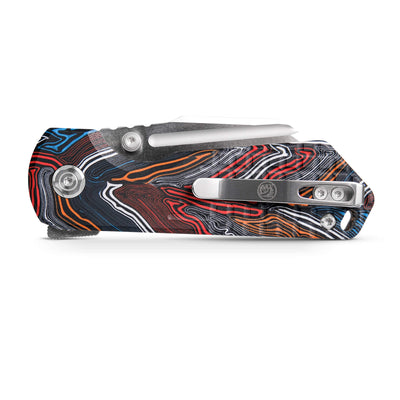Unlock the Secret to Choosing the Perfect Knife: Discover the Ultimate Materials!
Choosing the right knife is crucial for anyone who enjoys cooking or needs a reliable tool for outdoor activities. Whether you're chopping vegetables, filleting fish, or carving meat, the material your knife is made from significantly impacts its performance, durability, and maintenance. Knives can be crafted from various materials, each offering unique advantages and disadvantages. Understanding these materials will help you make an informed decision when purchasing a knife, ensuring you select one that meets your specific needs. In this article, we will explore the best materials for knives, providing insights into their characteristics, benefits, and ideal uses.

Understanding Knife Materials
Knife materials refer to the substances used to create the blade and handle of a knife. The choice of material is significant in knife making, as it determines the knife's hardness, sharpness, weight, and resistance to wear and corrosion. High-quality materials contribute to a knife's performance, ensuring it can withstand the rigors of its intended use. When selecting a knife, it's essential to consider not only the blade material but also the handle material, as both aspects contribute to the overall usability and comfort of the knife.
Common Knife Materials
Several materials are widely used in knife production, each offering distinct benefits and drawbacks. Understanding these can help you choose the right knife for your needs. The most common materials include stainless steel, carbon steel, ceramic, and titanium. Each has unique properties that make them suitable for different applications.
Stainless Steel
Stainless steel is one of the most popular knife materials due to its excellent corrosion resistance and low maintenance requirements. This material retains its sharpness well and is often used in kitchen knives because it doesn't rust easily, making it ideal for food preparation. However, while stainless steel knives are durable, they can be more challenging to sharpen than other materials. Many home cooks, including my friends who frequently cook for large gatherings, prefer stainless steel knives for their reliability and ease of use.
Carbon Steel
Carbon steel knives are favored by chefs and outdoor enthusiasts for their ability to achieve a razor-sharp edge and retain it longer than stainless steel. They are known for their superior cutting performance and ease of sharpening. However, carbon steel is more prone to rust and staining, requiring regular maintenance to prevent corrosion. A friend of mine, an avid fisherman, swears by his carbon steel fillet knife for its sharpness, but he also emphasizes the importance of drying it thoroughly after each use to maintain its integrity.
Ceramic
Ceramic knives are lightweight and extremely hard, which allows them to maintain a sharp edge longer than both stainless and carbon steel. They are ideal for slicing fruits and vegetables with precision. However, their brittleness can make them susceptible to chipping, and they cannot be sharpened using conventional methods. My friend, who loves meal prepping, enjoys using ceramic knives for their lightweight design and sharpness, but she is careful to avoid cutting through bone or frozen foods.
Titanium
Titanium knives are known for their exceptional strength and lightweight nature, making them suitable for specialized applications such as diving or survival situations. While they are not as common for everyday kitchen use, their durability and resistance to corrosion are significant advantages. Some outdoor enthusiasts prefer titanium knives for their ruggedness and lightweight, especially during long hikes. A colleague of mine always carries a titanium pocket knife for camping trips, appreciating how it withstands the elements without adding unnecessary weight.
Choosing the Right Material for Your Needs
When selecting the best knife material for your needs, it's essential to consider how you intend to use it. For cooking, stainless steel or carbon steel may be the best option, depending on your willingness to maintain the knife. If you're looking for something lightweight and easy to handle for precise cutting, ceramic might be the way to go. For outdoor activities, consider titanium for its durability and strength. Additionally, think about factors like maintenance and performance; a knife that requires regular upkeep might not be suitable for everyone. Evaluating these aspects will help you choose a knife that not only meets your functional needs but also fits your lifestyle.
Care and Maintenance of Knives Based on Material
Proper care and maintenance are vital for extending the life of your knives, regardless of their material. For stainless steel knives, regular cleaning with soap and water and thorough drying will prevent water spots and corrosion. Carbon steel knives need to be cleaned and dried immediately after use to avoid rust. Sharpening should be done regularly to maintain their edge. Ceramic knives require special care; they should be washed by hand and stored safely to prevent chipping. Titanium knives are generally low-maintenance, but it's still essential to clean them after use to keep them in good condition. Proper storage, such as using a knife block or magnetic strip, can also protect your knives from damage.
Key Considerations for Knife Material Selection
In conclusion, selecting the right material for your knife is crucial for ensuring optimal performance and longevity. Each material offers distinct advantages and disadvantages that make it suitable for specific uses. Whether you're a home cook, an outdoor enthusiast, or someone who simply enjoys a well-crafted knife, understanding these materials will guide you in making an informed choice. Remember to consider your specific needs and maintenance preferences before making a purchase, as this will ultimately enhance your experience and satisfaction with your knife.







